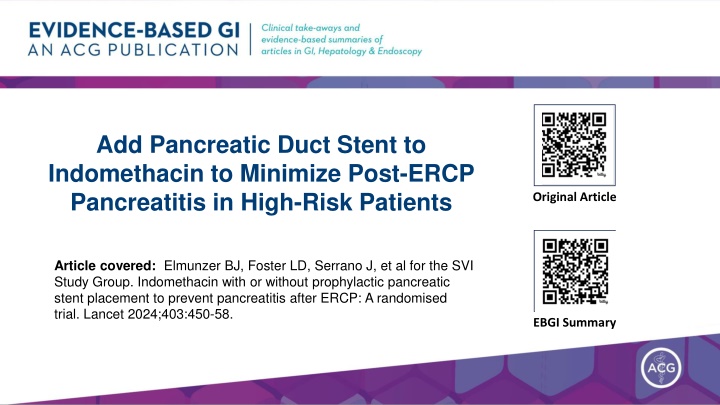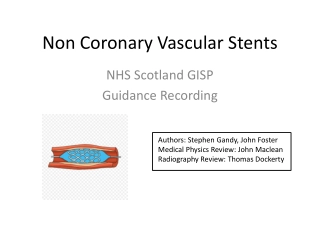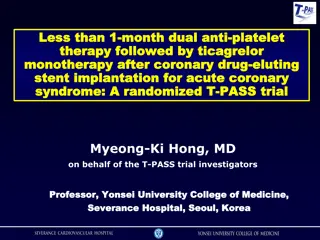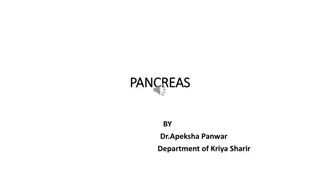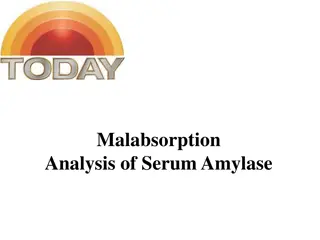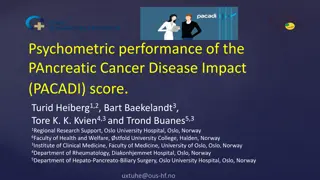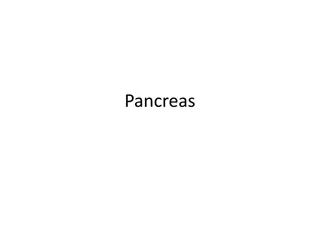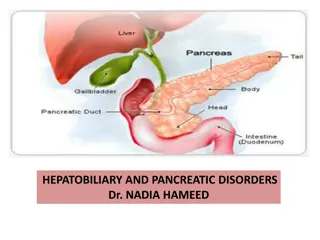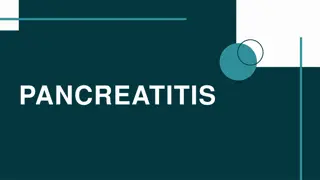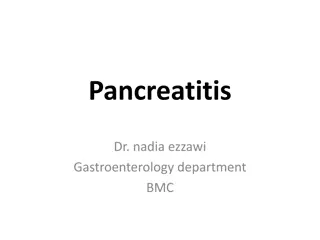Pancreatic Duct Stent in Minimizing Post-ERCP Pancreatitis
Add a pancreatic duct stent to indomethacin for post-ERCP pancreatitis prevention in high-risk patients. Rectal indomethacin + stent vs. indomethacin alone efficacy highlighted in a Lancet trial conducted by the SVI Study Group. Importance of reducing post-ERCP pancreatitis risk, ASGE guidelines, and the design of the multi-center, triple-blind, non-inferiority trial explained. Study patients' inclusion criteria detailed.
Download Presentation

Please find below an Image/Link to download the presentation.
The content on the website is provided AS IS for your information and personal use only. It may not be sold, licensed, or shared on other websites without obtaining consent from the author.If you encounter any issues during the download, it is possible that the publisher has removed the file from their server.
You are allowed to download the files provided on this website for personal or commercial use, subject to the condition that they are used lawfully. All files are the property of their respective owners.
The content on the website is provided AS IS for your information and personal use only. It may not be sold, licensed, or shared on other websites without obtaining consent from the author.
E N D
Presentation Transcript
Add Pancreatic Duct Stent to Indomethacin to Minimize Post-ERCP Pancreatitis in High-Risk Patients QR Code Original Article Article covered: Elmunzer BJ, Foster LD, Serrano J, et al for the SVI Study Group. Indomethacin with or without prophylactic pancreatic stent placement to prevent pancreatitis after ERCP: A randomised trial. Lancet 2024;403:450-58. QR Code EBGI Summary
Study Question Is rectal indomethacin non-inferior to rectal indomethacin+prophylactic pancreatic duct (PD) stent placement for minimizing post-endoscopic retrograde cholangiopancreatography (ERCP) pancreatitis in high-risk patients?
Why Is This Important? Post-ERCP pancreatitis is a severe complication, affecting up to 15% of high-risk patients, leading to hospitalization and potentially death. PD stenting can minimize this risk but is time-consuming, may be technically difficult, increase costs, and may require follow-up EGD if the stent doesn't pass spontaneously. Rectal NSAID administration with indomethacin reduces the risk of post-ERCP pancreatitis and is now widely employed, which has led to decreased use of prophylactic PD stent placement. Kaimakliotis PI, et al. Lancet 2024;403:411-13; Buxbaum JL, et al. Gastrointest Endosc 2023;97:153-62; Elmunzer BJ, et al. N Engl J Med 2012;366:1414-22; Smith ZL, et al. Am J Gastroenterol 2020;115:934-40; Ashat M, et al. Gastrointest Endosc 2023;97:1059-66; Schoenfeld P. EBGIFeb 2024:1-5.
Why Is This Important? ASGE guidelines recommend both rectal indomethacin and PD stent placement for high- risk patients even though without Level 1 RCT evidence. The Stent vs Indomethacin (SVI) Study Group conducted a seminal RCT in 20 centers among over 100 advanced endoscopists and nearly 2,000 patients to assess this issue. Kaimakliotis PI, et al. Lancet 2024;403:411-13; Buxbaum JL, et al. Gastrointest Endosc 2023;97:153-62; Elmunzer BJ, et al. N Engl J Med 2012;366:1414-22; Smith ZL, et al. Am J Gastroenterol 2020;115:934-40; Ashat M, et al. Gastrointest Endosc 2023;97:1059-66; Schoenfeld P. EBGIFeb 2024:1-5.
Study Design Design: Multi-center, prospective, randomized, *triple- blind, non-inferiority trial. + Setting: 20 referral centers in U.S. and Canada and >100 advanced endoscopists of varying experience participated. Duration: September 2015 - January 2023 *Triple-blinding: Patients, post-ERCP caregivers, and outcome adjudicators were all masked to treatment assignment. Endoscopists who performed ERCP were not allowed to participate in patient care for 48 hours post-ERCP. Elmunzer BJ, Foster LD, Serrano J, et al. Lancet 2024;403(10425):450-458; Schoenfeld P. EBGI Feb 2024:1-5.
Study Patients Inclusion Criteria: Adults > 18 years old who had no indication for PD stent placement except pancreatitis prevention and met one or more criteria for increased risk of post-ERCP pancreatitis: History of post-ERCP pancreatitis Difficult cannulation (> 6 cannulation attempts or > 6-minute duration of cannulation) Precut sphincterotomy Pancreatic sphincterotomy Short duration (< 1 min) balloon dilation of an intact biliary sphincter or clinical suspicion of sphincter of Oddi dysfunction Patients could also be enrolled if they met > 2 minor criteria: female sex and age < 50 years old, history of recurrent pancreatitis, or > 3 PD injections. Elmunzer BJ, Foster LD, Serrano J, et al. Lancet; 2024;403(10425):450-458, Schoenfeld P. EBGI Feb 2024:1-5.
Interventions Patients were randomly assigned in a 1:1 ratio to receive: Two 50 mg indomethacin suppositories peri-procedurally OR Two 50 mg indomethacin suppositories peri-procedurally plus prophylactic pancreatic duct (PD) stent placement All procedure-related interventions, including technical approach to PD stent placement, were at the discretion of the endoscopist. Elmunzer BJ, Foster LD, Serrano J, et al. Lancet 2024;403(10425):450-458; Schoenfeld P. EBGI Feb 2024:1-5.
Outcomes & Definitions Primary Outcome: Post-ERCP pancreatitis Defined as new onset or increase in abdominal pain; elevation of pancreatic enzymes >3x the ULM 24 hours after ERCP; and hospitalization for at least 2 nights. This validated definition was applied as a diagnostic framework by three experts at non-enrolling centers who were blinded to patient allocation and required agreement by 2 of 3 adjudicators. Secondary Outcome: Moderate or severe post-ERCP pancreatitis, using same diagnostic framework, with assessment of radiographic data to determine severity of pancreatitis. Elmunzer BJ, Foster LD, Serrano J, et al. Lancet 2024;403(10425):450-458; Schoenfeld P. EBGI Feb 2024:1-5.
Data Analysis Intention-to-Treat (ITT) and per-protocol analyses were reported. Prophylactic PD stent placement unsuccessful in 19.3% of patients assigned to PD stent + rectal indomethacin group. In the ITT analysis, these patients were included in the PD stent + rectal indomethacin group analysis but were excluded in the per-protocol analysis. Non-inferiority margin was defined as 5%. Hence, if there were < 5% increased absolute risk of post-ERCP pancreatitis in the upper bound of the two-sided 95% confidence interval for the rectal indomethacin alone group, then it would be considered non-inferior to prophylactic PD stent placement plus rectal indomethacin. Elmunzer BJ, Foster LD, Serrano J, et al. Lancet 2024;403(10425):450-458; Schoenfeld P. EBGI Feb 2024:1-5.
Results Study Population: Among 1,950 randomized patients 38.7% male Mean age 55.7 years 83.8% White 26%-27% had suspected sphincter of Oddi dysfunction 82%-84% had difficult cannulation 10%-12% required precut sphincterotomy for access Elmunzer BJ, Foster LD, Serrano J, et al. Lancet 2024;403(10425):450-458; Schoenfeld P. EBGI Feb 2024:1-5.
Results Per-protocol analysis (14.4% vs 11.6%) for primary outcome, post-ERCP pancreatitis, produced similar results to ITT analysis. Elmunzer BJ, Foster LD, Serrano J, et al. Lancet. 2024;403(10425):450-458; Schoenfeld P. EBGI Feb 2024:1-5.
Key Study Findings Rectal indomethacin is NOT non-inferior to rectal indomethacin plus PD stent placement to prevent post-ERCP pancreatitis in high-risk patients. Post-ERCP pancreatitis occurred in significantly more patients in the rectal indomethacin alone group vs rectal indomethacin + prophylactic PD stent placement (14.9% vs 11.3%, respectively; Risk Difference: 3.6%; 95% CI: 0.6-6.6) Relative risk difference (RR=1.32; 95% CI: 1.05-1.66)indicates that high-risk patients had > 30% increased risk of post-ERCP pancreatitis without PD stent placement. Elmunzer BJ, Foster LD, Serrano J, et al. Lancet 2024;403(10425):450-458; Schoenfeld P. EBGI Feb 2024:1-5.
Study Limitations PD stent placement procedures were not standardized, including selection of PD stent, and duration and number of attempts at PD stent placement. This lack of standardization is understandable because there is no established protocol for prophylactic PD stent placement. Elmunzer BJ, Foster LD, Serrano J, et al. Lancet 2024;403(10425):450-458; Schoenfeld P. EBGI Feb 2024:1-5.
How Should We Apply This to Our Practice? Based on these data and ASGE Guideline, should PD stent placement become routine in high-risk patients as defined in this study? What is the optimal approach to PD stent placement, including selection of PD stent based on length and diameter? What is the optimal approach to intravenous fluid bolus to minimize post-ERCP pancreatitis risk? Study s primary author boluses most ERCP patients with 2.5-3.0 liters of lactated Ringer s (LR) solution intravenously during the peri-procedural period unless they are elderly and/or have cardiovascular or pulmonary disease, but this has not yet been demonstrated to minimize post-ERCP pancreatitis in well-designed RCTs. Schoenfeld P. EBGI Feb 2024:1-5.
